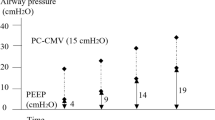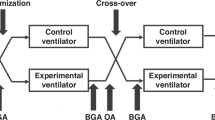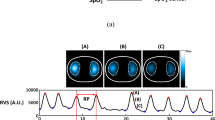Abstract
With the use of constant flow, end-inspiratory airway occlusion, respiratory system resistance (Rrs) can be partitioned into a flow resistive component (Rint) and an additional component (ΔR), reflecting viscoelasticity and time constant inequality. Similarly, respiratory system elastance (Edyn) can be partitioned into static elastance (Est) and elastance due to viscoelasticity and time constant inequality (ΔE). We measured Rrs and Edyn and their subdivisions (Rint and ΔR, Est and ΔE, respectively) and studied their flow and volume dependence in eight otherwise healthy children (median age 3.6 y; range 1.9–5.2 y) undergoing general anesthesia for oral rehabilitation. With a constant inspiratory flow (VI) of approximately 15 mL/s/kg and tidal volume of 12 mL/kg, the mean values of Rrs, Rint, and ΔR were: 0.20, 0.11, and 0.10 cmH2O/mL/s·kg. Under the same conditions, the mean Est and ΔE were: 1.04 and 0.12 cmH2O/mL/kg. With increasing VI and under constant VT, ΔR decreased (p< 0.001) progressively. Rint also decreased paradoxically (p< 0.001). Hence, Rrs decreased (p< 0.001) with increasing VI. Est decreased (p< 0.001) with increasing VI, whereas ΔE increased (p< 0.005). With increasing VT and under constant VI, Rint decreased (p< 0.001) and ΔR tended to increase (p= 0.058); Rrs did not change. With increasing VT under constant VI, both Est and ΔE decreased (p< 0.001 and p= 0.001, respectively). Thus, in contrast to the findings in adults, Rint and Est decreased in children with increasing flow and under constant tidal volume, probably reflecting decreased functional residual capacity in anesthetized children, compared with adults. The flow and volume dependence of ΔR and ΔE were similar to those in adults, whereas Rrs did not necessarily follow the direction of changes of ΔR.
Similar content being viewed by others
Log in or create a free account to read this content
Gain free access to this article, as well as selected content from this journal and more on nature.com
or
Abbreviations
- C:
-
compliance
- ΔE:
-
elastance of the respiratory system due to tissue viscoelasticity and time constant inequality
- Edyn:
-
dynamic elastance of the total respiratory system
- Est:
-
static elastance of the total respiratory system
- ET tube:
-
endotracheal tube
- FRC:
-
functional residual capacity
- Pao:
-
airway opening pressure proximal to ET tube
- PEEP:
-
positive end-expiratory pressure
- ΔR:
-
respiratory system resistance due to tissue viscoelasticity and time constant inequality
- Rint:
-
intrinsic flow resistance
- Rrs:
-
total respiratory system resistance
- TI:
-
inspiratory time
- ΔV:
-
gas volume
- VI:
-
constant inspiratory flow
- VT:
-
tidal volume
References
Kochi T, Okubo S, Zin WA, Milic-Emili J 1988 Flow and volume dependence of pulmonary mechanics in anesthetized cats. J Appl Physiol 64: 441–450.
Bates JHT, Ludwig MS, Sly PD, Brown K, Martin JG, Fredburg JJ 1988 Interrupter resistance elucidated by alveolar pressure measurement in open-chest normal dogs. J Appl Physiol 65: 408–414.
D'Angelo E, Calderini E, Torri G, Robatto FM, Bono D, Milic-Emili J 1989 Respiratory mechanics in anesthetized paralyzed humans: effects of flow, volume, and time. J Appl Physiol 67: 2556–2564.
D'Angelo E, Robatto FM, Calderini E, Tavola M, Bono D, Torri G, Milic-Emili J 1991 Pulmonary and chest wall mechanics in anesthetized paralyzed humans. J Appl Physiol 70: 2602–2610.
Auler JOC Jr, Salvida PHN, Martins MA, Carvalho CRR, Negri EM, Hoelz C, Zin WA 1990 Flow and volume dependence of respiratory system mechanics during constant flow ventilation in normal subjects and in adult respiratory distress syndrome. Crit Care Med 18: 1080–1086.
Eissa NT, Ranieri VM, Corbeil C, Chassé M, Robatto FM, Braidy J, Milic-Emili J 1991 Analysis of behavior of the respiratory system in ARDS patients: : effects of flow, volume, and time. J Appl Physiol 70: 2719–2729.
Tantucci C, Corbeil C, Chassé M, Braidy J, Matar N, Milic-Emili J 1991 Flow resistance in patients with chronic obstructive pulmonary disease in acute respiratory failure. Am Rev Respir Dis 144: 384–389.
Tantucci, Corbeil C, Chassé M, Braidy J, Matar N, Milic-Emili J 1993 Flow resistance in mechanically ventilated patients with severe neurological injury. J Crit Care 8: 133–139.
Pelosi P, Croci M, Ravagnan I, Cerisara M, Vicardi P, Lissoni A, Gattinoni L 1997 Respiratory system mechanics in sedated, paralyzed, morbidly obese patients. J Appl Physiol 82: 811–818.
Storme L, Riou Y, Logier R, Dubos JP, Kacet N, Rousseau S, Lequien P 1994 A new application of an old method for respiratory mechanics measurements: : the passive inflation method in newborn infants during pressure-controlled ventilation. Pediatr Pulmonol 18: 244–254.
Lanteri CJ, Sly PD 1993 Changes in respiratory mechanics with age. J Appl Physiol 74: 369–378.
Freezer NJ, Butt W, Sly PD 1991 Pulmonary mechanics and outcome of neonates on ECMO. Pediatr Pulmonol 11: 108–112.
Freezer NJ, Sly PD 1993 Predictive value of measurements of respiratory mechanics in preterm infants with HMD. Pediatr Pulmonol 16: 116–123.
Freezer NJ, Lanteri CJ, Sly PD 1993 Effect of pulmonary blood flow on measurements of respiratory mechanics using the interrupter technique. J Appl Physiol 74: 1083–1088.
Galal MW, Habib RH, Jaeger DD, Lister G 1998 Effects of rate and amplitude of breathing on respiratory system elastance and resistance during growth of healthy children. Pediatr Pulmonol 25: 270–277.
Motoyama EK 1996 Induction of anesthesia and endotracheal intubation. In: Motoyama EK, Davis PJ (eds) Smith's Anesthesia for Infants and Children, 6 ed. Mosby, St. Louis, 281–312.
Milic-Emili J, Robatto FM, Bates JHT 1990 Respiratory mechanics in anaesthesia. Br J Anaesth 65: 4–12.
Sly PD, Brown KA, Bates JHT, Spier S, Milic-Emili J 1988 Noninvasive determination of respiratory mechanics during mechanical ventilation of neonates: : a review of current and future techniques. Pediatr Pulmonol 4: 39–47.
Jackson AC, Milhorn HT Jr, Norman JR 1974 A reevaluation of the interrupter technique for airway resistance measurement. J Appl Physiol 36: 264–268.
Sly PD, Bates JHT, Milic-Emili J 1987 Measurement of respiratory mechanics using the Siemens Servo Ventilator 900C. Pediatr Pulmonol 3: 400–405.
Zeltner TB, Burri PH 1987 The postnatal development and growth of the human lung. II. Morphology. Respir Physiol 67: 269–282.
Papastamelos CH, Panitch HB, England SE, Allen JL 1995 Developmental changes in chest wall compliance in infancy and early childhood. J Appl Physiol 78: 179–184.
Rohrer F 1915 Der Strömungswiderstand in den menschlichen Atemwegen und der Einfluss der unregelmässigen Verzweigung des Bronchialsystems auf den Atmungsverlauf in verschiedenen Lungenbezirken. Pfluegers Arch Gesamte Physiol Menschen Tiere 162: 225–299.
Briscoe WA, DuBois AB 1958 The relationship between airway resistance, airway conductance and lung volume in subjects of different age and body size. J Clin Invest 37: 1279–1285.
Westbrook PR, Stubbs SE, Sessler AD, Rehder K, Hyatt RE 1973 Effects of anesthesia and muscle paralysis on respiratory mechanics in normal man. J Appl Physiol 34: 81–86.
de Troyer A, Bastenier-Geens J 1979 Effects of neuromuscular blockade on respiratory mechanics in conscious man. J Appl Physiol 47: 1162–1168.
Sharp JT, Druz WS, Balagot RC, Bandelin VR, Danon J 1970 Total respiratory compliance in infants and children. J Appl Physiol 29: 775–779.
Dobbinson TL, Nisbet HI, Pelton DA, Levison E 1973 Functional residual capacity (FRC) and compliance in anaesthetized paralyzed children. Can Anaesth Soc J 20: 322–333.
Agostoni E 1959 Volume-pressure relationships of the thorax and lung in the newborn. J Appl Physiol 14: 909–913.
Marshall R, Widdicombe JG 1960 Stress relaxation of the human lung. Clin Sci 20: 19–31.
Bates JHT, Rossi A, Milic-Emili J 1985 Analysis of the behavior of the respiratory system with constant inspiratory flow. J Appl Physiol 58: 1840–1848.
Motoyama EK 1977 Pulmonary mechanics during early postnatal years. Pediatr Res 11: 220–223.
Tepper RS, Morgan WJ, Cota K, Wright A, Taussig LM 1986 Physiological growth and development of the lung during the first year of life. Am Rev Respir Dis 134: 513–519.
Similowski T, Levy P, Corbeil C, Albala M, Pariente R, Derenne J-P, Bates JHT, Johnson B, Milic-Emili J 1989 Viscoelastic behavior of lung and chest wall in dogs determined by flow interruption. J Appl Physiol 67: 2219–2229.
Bryan AC, Wohl MEB 1986 Respiratory mechanics in children. In: Fishman AP, Macklem PT, Mead J (eds) Handbook of Physiology. Mechanics of Breathing, Sect 3, Vol III. American Physiological Society, Bethesda, 179–191.
Gerhart T, Hehre D, Feller R, Reifenberg L, Bancalari E 1987 Pulmonary mechanics in normal infants and young children during the first five years of life. Pediatr Pulmonol 3: 309–316.
Thorsteinsson A, Larsson A, Jonmarker C, Werner O 1994 Pressure-volume relations of the respiratory system in healthy children. Am J Respir Crit Care Med 150: 421–430.
Acknowledgements
The authors thank David Chasey for his editorial assistance.
Author information
Authors and Affiliations
Additional information
Supported by intramural funds of the Department of Anesthesiology and Critical Care Medicine, University of Pittsburgh and Children's Hospital of Pittsburgh.
Rights and permissions
About this article
Cite this article
Kaditis, A., Motoyama, E., Seki, I. et al. Flow and Volume Dependence of Respiratory Mechanics in Anesthetized Children. Pediatr Res 46, 419 (1999). https://doi.org/10.1203/00006450-199910000-00010
Received:
Accepted:
Issue date:
DOI: https://doi.org/10.1203/00006450-199910000-00010



